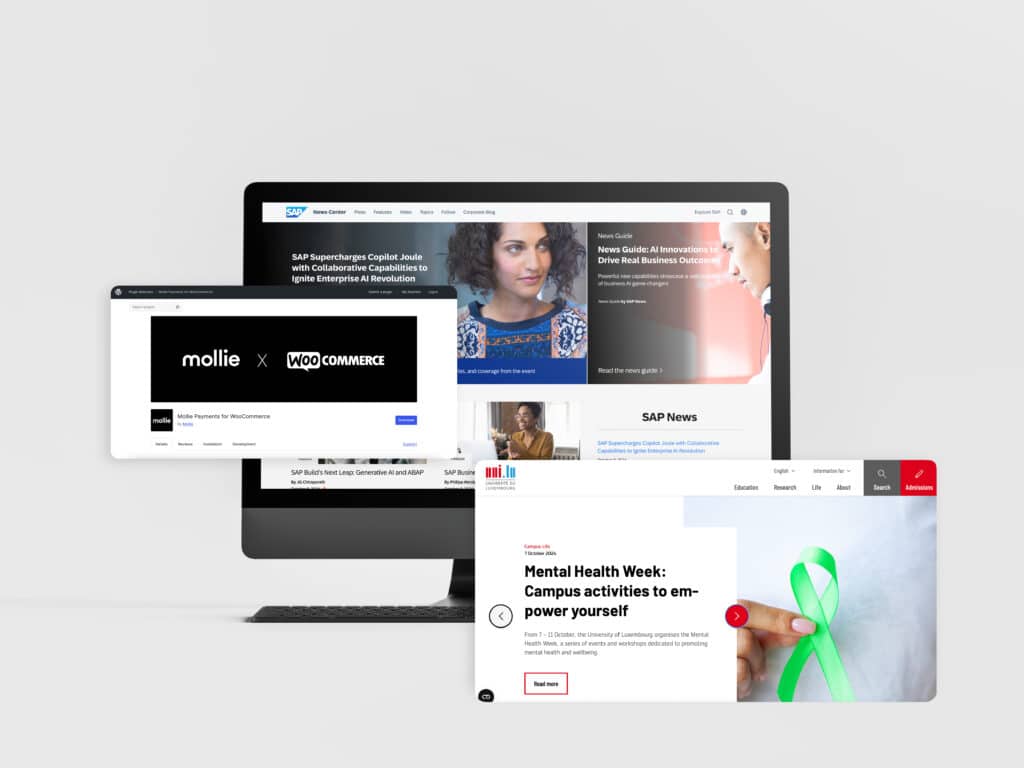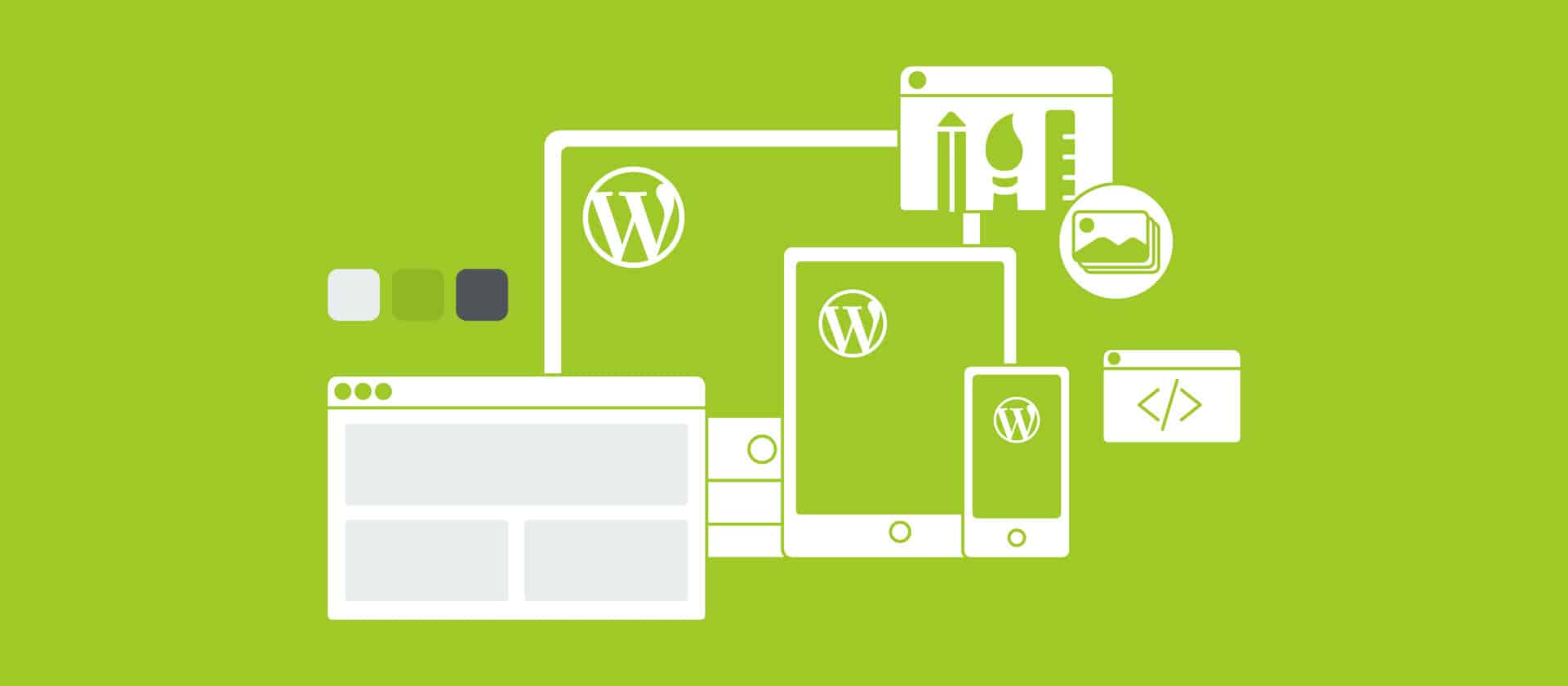Ideally with open source based on WordPress. The idea behind this sounds understandable and, at first glance, realisable: “We know exactly what we need. A few good plugins, a smart theme and a developer to put it all together.” The effort is manageable and the goals realistic. But on closer inspection, it becomes clear that there is much more to modern company websites than an appealing front end and a solid CMS.
As soon as several specialist departments are involved, different target groups are to be served and the project is to become not just a digital shop window but a strategically relevant platform, the requirements change fundamentally. Content must be maintained in a structured manner, data must be processed securely, processes must be mapped efficiently and systems must be integrated seamlessly. An ‘off-the-shelf theme’ is no longer enough. Focussing solely on “somehow works” will lead to long-term failure.
What distinguishes an enterprise website from a standard project
Many companies underestimate this. A website in an enterprise context is not an isolated project. It is part of a larger digital ecosystem with dependencies on CRM systems, product databases, applicant portals, apps and translation tools. And then there are the various stakeholder groups with their own requirements. Marketing needs maximum design freedom, IT needs security and maintainability, the editorial team wants to manage content efficiently and management requires key figures on reach and conversion.
This multitude of requirements demands more than just technical implementation. It requires conceptual clarity, structured processes and a resilient technical foundation. A website for a growing company must be thought through, planned and grown with it. This is precisely where we differ from smaller web projects: Not only in terms of scope, but also in terms of scalability, future viability and strategic relevance.
Why ready-made WordPress themes and plugins quickly reach their limits with large websites
With WordPress, it is easy to fall back on existing solutions. After all, there are countless free and paid themes and plugins. They can be installed with just a few clicks and, at first glance, cover every conceivable feature for every purpose. This may work for less complex websites with low security requirements and manageable traffic. In the enterprise environment, however, this approach often leads to a dead end.
Ready-made themes offer a multitude of features and styling presets that are often not needed in practice. The supposed ‘everything already included’ advantage quickly becomes a disadvantage when unnecessary code slows down performance or customisations prove to be cumbersome and error-prone. Although plugins offer specific solutions, seamless integration into the overall system is rare. It is also unclear how long they will be maintained, whether they will receive security-relevant updates or remain compatible with future WordPress versions. It is also essential that third-party plugins are solidly developed and do not reach their limits in terms of growing traffic. Such plugins should no longer cause major problems over time, as they can overfill the database, for example, and thus become a real bottleneck.
Those who opt for proprietary plug-in solutions become dependent on the respective developers. Later on, this ‘lock-in effect’ becomes noticeable not only from the original provider, but often also from a specific system architecture. Individually developed, maintainable solutions that are closely orientated towards the WordPress core create significantly more future security here, especially if internal teams or other service providers are to take over later.
Multiple languages for WordPress websites: WPML vs. MultilingualPress
For internationally active companies, multilingualism is not an option, but a standard. The technical implementation in WordPress can vary greatly, especially when it comes to choosing the right plugin. Many rely on the WPML plugin out of habit. What is often overlooked: WPML saves all language versions in a common database structure and links them via internal IDs. If the plugin is deactivated, the system loses the assignment and the multilingual content is no longer easily accessible.
And the amount of stored content grows quickly with extensive language versions. This increases the load on the database considerably. As a result, performance and scalability suffer. This is particularly noticeable with extensive instances with many articles, products or pages.
MultilingualPress takes a different approach: each language is mapped as a separate subsite with its own URL structure. For example, /en/, /fr/, /de/ subpages are automatically created for each individual language. This separation ensures technical clarity and guarantees better performance and maintainability. The big advantage: even if the plugin is deactivated, the complete content remains fully intact and accessible. It is also seamlessly connected to the WordPress core and fits perfectly into existing multisite structures, making it ideal for companies that prioritise sustainability, stability and flexibility.
Project management in an enterprise context: control instead of self-administration
Project management is an often underestimated but central aspect of complex web projects. In smaller projects, control can still be handled directly by the customer. In a company-wide setup, the situation is quite different. Here, different interests, processes and specialist areas collide over a period of weeks or months.
Good project management ensures adherence to deadlines and budget control. It creates structure, transparency and reliability. It mediates between those involved, prioritises requirements, moderates conflicts of objectives and identifies technical or organisational hurdles at an early stage. In practice, it is precisely this overarching coordination that makes projects stable and predictable. It is the task of professional project management to ensure that the strategic goals in the digital space of various stakeholders of a large company are actually achieved.
Project management is therefore not an ‘agency extra’, but a key role, especially in scenarios in which the web project not only replaces a website, but also transforms processes and sets new digital standards in the company.

Strategic design for enterprise websites instead of visual gut decisions
When it comes to the visual appearance of a website, there is often the impression that you “just have to realise it”. Colours, shapes, content: Everything has long been conceptualised and clearly defined. What is often overlooked: Good design doesn’t start with Photoshop, Figma or Canva, but with an understanding of target groups, usage contexts and technical framework conditions.
Especially for larger websites, design is not an end in itself, but a strategic tool. It creates orientation, structures information and translates complex content into intuitive user interfaces. This requires more than just aesthetic flair. It requires a systematic approach, from analyses, wireframes and user flows through to scalable design systems that remain consistent even with future expansions.
And last but not least, it’s about digital accessibility. Anyone designing for a broad audience today must ensure that content can be used by everyone. Accessibility, performance and responsive behaviour are all part of the design responsibility. And it also determines whether a website is actually used or just looks good. The Barrierefreiheitsstärkungsgesetz (BFSG or EAA, European Accessibility Act) even legally stipulates the requirement for easily accessible content and clear navigation. Enterprise websites must fulfil this standard, otherwise there is a risk of heavy fines.
Security, performance & maintainability for enterprise websites
In smaller web projects, security and performance often only become an issue when something is not working. In an enterprise environment, they should be at the centre of planning right from the start. Anyone who is visible with large brands is automatically operating in a highly sensitive area, be it in terms of data protection, regulatory requirements or simply public perception.
A high-performance website is not a technical nice-to-have, but essential for the user experience, search engine optimisation (SEO) and conversion. But real speed does not come from caching alone. It starts with a clean architecture, an efficient code base, lean queries and carefully selected interfaces. Every technical decision has a long-term effect on maintainability and expandability.
The same applies to security: 3rd party plugins or publicly available themes are quickly installed and save time in the short term, but can harbour risks in the long term. Companies not only need technical security here, but also a well thought-out security concept that includes regular audits, monitoring and clear deployment and update processes. Anyone working in this environment without quality assurance is acting negligently.
Complex websites are not a sprint: Why quality takes time (and structure)
“We need the website in four weeks” – a sentence that sounds feasible in theory, but usually remains an illusion in practice. While smaller projects can perhaps be realised in a few weeks, the reality is different for enterprise projects. This is not about templates and text modules, but about a stable, scalable foundation that takes future requirements into account. Such web projects take time and cannot be completed in just a few weeks.
Enterprise websites go through clearly structured phases from requirements analysis, concept, design, development and quality assurance through to final migration and go-live. Each of these phases is important, as this is the only way we can minimise the risk of having to accept later rebuilds or cost-intensive detours. Clean processes are essential, especially when there are multiple stakeholders or interfaces to internal systems.
In professional projects, the focus is not on speed but on predictability. Working with realistic time frames improves quality and creates trust. And this applies both internally and externally. A website is not a sprint, but a foundation for years to come. And it shouldn’t be poured on the fly.
Understanding a website as a digital investment with a long-term effect
A solidly developed website in an enterprise context does not show its true performance immediately after the go-live, but in the months and years that follow. The true value of digital quality unfolds when content is maintained efficiently, systems are integrated smoothly and new requirements can be implemented quickly.
A well thought-out technical architecture saves resources, because editorial processes run faster, extensions can be realised without costly conversion measures, security gaps are detected and rectified at an early stage. And from a marketing perspective, a scalable platform also means more agility. When launching new campaigns, microsites or language versions, a website that has been clearly thought through from the outset and has a solid technical foundation is always an advantage.
Especially in a globally active company with different target groups and markets, a WordPress-based enterprise solution offers numerous strategic options: Multisite setups, headless architectures or DXP approaches can be implemented with the right partners and enable a consistent, brand-compliant experience across all touchpoints.
Investing in quality means investing in digital agility. And that is a decisive competitive advantage today, regardless of industry or business model.
When enterprise solutions for websites are worthwhile and when they are not
Not every project needs a customised architecture, a design system or a dedicated QA team. For smaller companies with a limited range of functions and no special integration requirements, a simple solution is definitely expedient. However, as soon as digital processes become business-critical, for example in marketing, sales or internal communication, the requirements change fundamentally.
An enterprise website is not a short-term product, but a strategic platform. It requires a willingness to invest, a clear definition of goals and the will not only to demand digital quality, but also to enable it. Agencies that specialise in precisely this segment bring not only technical expertise but also the necessary process understanding to successfully implement such projects.
As an experienced WordPress agency, Syde is focussed precisely on these requirements. With an interdisciplinary, global team of more than 130 employees, over 18 years of project experience and a clear commitment to scalability and quality, we support companies on their path to digital excellence – from the initial idea to well beyond the launch.
If you are looking for a digital foundation that grows with your company, you should not start your journey with standard solutions. Now is the right time to talk about the right strategy.
Power Your Enterprise With WordPress.

Related articles
-

Rethinking WordPress Multisite: Simpler, Smarter, More User-Friendly
When WordPress 3.0 was released back in 2010, named Thelonious after jazz pianist Thelonious Monk, it introduced a feature that fascinated me immediately: Multisite.
-

Contributing to Something Bigger: My Hacktoberfest Experience at Syde
Hacktoberfest has become a recurring highlight in my year and a moment that reminds me why I am committed to open source and why I enjoy being part of Syde.
